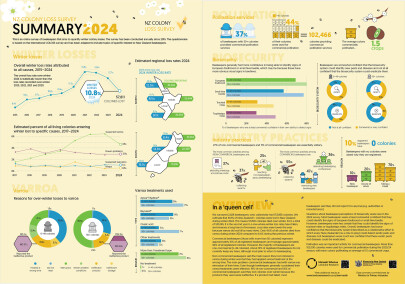2024 Colony Loss Survey
In this section
 Conducted annually since 2015, the New Zealand Colony Loss Survey is based on the survey of beekeepers developed by the international COLOSS honey bee research association.
Conducted annually since 2015, the New Zealand Colony Loss Survey is based on the survey of beekeepers developed by the international COLOSS honey bee research association.
Survey topics include the number and nature of over-winter colony losses, queen health and performance, indicators of diseases and parasites, treatment of Varroa, supplemental feeding, and colony management. Because the challenges facing New Zealand beekeepers differ from those facing beekeepers in the northern hemisphere, the survey also includes questions that are specific to the New Zealand context, e.g. apiary crowding, predation by wasps, and nectar flow from native trees.
Overview: In a 'queen cell'
We surveyed 2,828 beekeepers, who collectively had 153,856 colonies. We estimate that 10.8% of New Zealand’s colonies were lost in New Zealand during winter 2024. This means 57,800 colonies died over winter, from a total of 535,185. It is the second year in a row where winter loss rates have fallen, and reverses a long trend of increases. Loss rates were lower this year because varroa did not kill as many hives. Only 4.6% of all colonies died from varroa during winter 2024 compared to 6.4% during the previous winter.
Commercial beekeepers (those with more than 50 colonies) represent approximately 10% of all registered beekeepers and manage approximately 94% of all registered colonies. However, the majority of beekeepers are non-commercial (1–49 colonies). About 10% of registered beekeepers do not currently keep any bees, although most plan to return to beekeeping.
Non-commercial beekeepers said the main reason they lost colonies to varroa during winter was that they had applied varroa treatment at the wrong time. The main problem commercial beekeepers had with varroa was reinvasion of their hives. Even though beekeepers generally considered their varroa treatments were effective, 19% of non-commercial and 16% of commercial beekeepers said they lost colonies over winter because the products they used were ineffective. If a product had failed, most beekeepers said they did not report it to anyone (e.g. authorities or manufacturers).
Questions about beekeeper perceptions of biosecurity were new in the 2024 survey. Most beekeepers were at least somewhat confident that they could identify the signs of European foulbrood or small hive beetle. However, beekeepers were less certain that they could identify the signs of tracheal mites or tropilaelaps mites. Overall, beekeepers had some confidence that the biosecurity system (described as a collaborative effort in which every New Zealander has a role to play) could detect exotic pests and diseases, but beekeepers were much less confident that these exotic pests and diseases could be eradicated.
Pollination was an important activity for commercial beekeepers. More than 102,000 colonies were used for commercial pollination during the 2023/24 season, with each colony pollinating an average of 1.5 commercial crops.
Summary


























